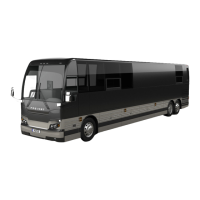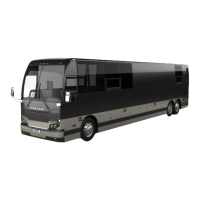SECTION 22: HEATING AND AIR CONDITIONING
DOB 1300-1556 | X3-45 Commuter PA-1648 Maintenance Manual First release Oct 2020
conditioning capacity of 7½ tons. The receiver
tank and filter dryer are mounted inside the
condenser compartment.
The schematic on FIGURE 4 shows the central
HVAC system’s cooling function arrangement.
6.7.1 Refrigeration Cycle
Refrigeration may be defined as the transfer of
heat from a place where it is not wanted to a
place where it is unobjectionable. The air
conditioning system used is the "closed" type
using R134a refrigerant.
1. The refrigerant flowing to the compressor is
compressed to high pressure and reaches a
temperature higher than the surrounding air.
It is passed through the air-cooled fins and
tubes of the condenser causing the hot,
high pressure gas to be condensed into a
liquid form.
2. The liquid refrigerant flows to the receiver
tank, then passes through a filter dryer
where moisture, acids and dirt are removed
and then through a moisture indicator which
indicates if any moisture is present in the
system.
3. By its own pressure, the liquid refrigerant
flows through a thermal expansion valve
where the pressure drop causes the
refrigerant to vaporize in a vapor-liquid state
at a low temperature pressure.
4. The cold low pressure refrigerant passes
through the passenger’s and driver’s unit
evaporator coils which absorb heat from the
air passing over the fins and tubes, and
changes into gas. In this form, the
refrigerant is drawn into the compressor to
repeat the air conditioning cycle.
5. The success of the air-conditioning system
depends on retaining the conditioned air
within the vehicle. All windows and intake
vents should be closed. An opening of
approximately 8 in
2
(5162 mm
2
) could easily
neutralize the total capacity of the system.
6. Other causes of inadequate cooling are
dirty coils or filter. Dirt acts as insulation and
is also serves as a restriction to the airflow.
7. The refrigeration load is not constant and
varies. It is also affected by outside
temperature, relative humidity, passenger
load, compressor speed, the number of
stops, etc.
The compressor will load depending on
operating conditions.
6.7.2 Refrigerant
The A/C system of this vehicle has been
designed to use R134a refrigerant as a medium.
Regardless of the brand, only R134a must be
used in this system. The chemical name for this
refrigerant is 1,1,1,2-Tetrafluoroethane.
WARNING
Refrigerant in itself is nonflammable, but if it
comes in contact with an open flame, it will
decompose.
Procurement
Refrigerant is shipped and stored in metal
cylinders. It is serviced in 30 and 100 pound
cylinders.
Approximately 24 lbs are needed in the Central
HVAC system plus an additional 2 lbs will be
needed for the overhead compartment A/C
system if equipped.
Refrigerant charge (Approximate)
Central A/C system: 24 lbs
Overhead comp. A/C system: 2 lbs
It will be impossible to draw the entire refrigerant
out of the cylinder. However, the use of warm
water or heating blanket when charging the
system will assure the extraction of a maximum
amount of refrigerant from the cylinder.
Precautions in Handling Refrigerant
1. Do not leave refrigerant cylinder uncapped.
2. Do not subject cylinder to high
temperatures, do not weld or steam clean
near system or cylinder.
3. Do not fill cylinder to more than 80% liquid
full to allow for refrigerant expansion.
4. Do not discharge vapor into an area where
a flame is exposed.
5. Do not expose the eyes to liquid refrigerant.
All refrigerant cylinders are shipped with a heavy
metal screw cap. The purpose of the cap is to
protect the valve and safety plug from damage.
It is a good practice to replace the cap after

